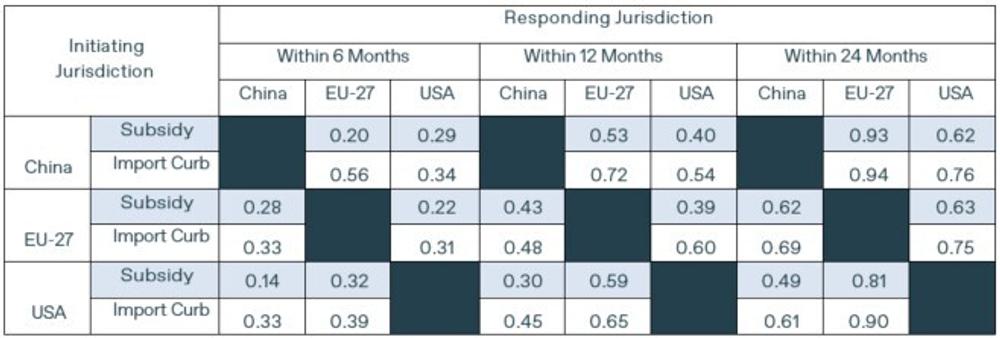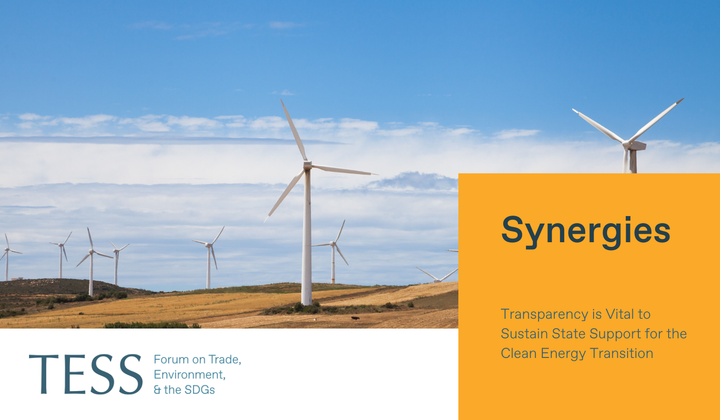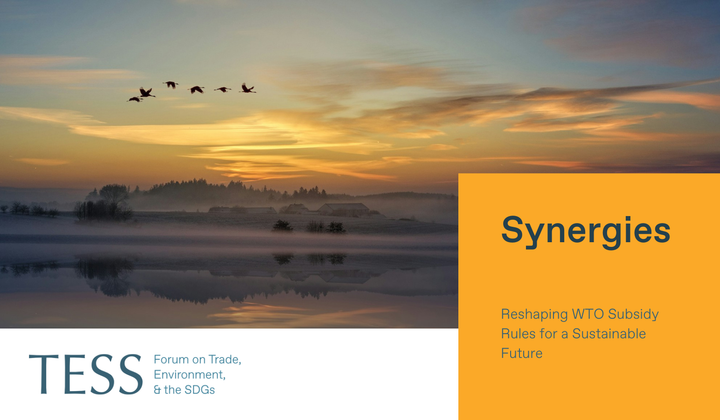National support measures for firms in sectors conducive to the net-zero transition are typically justified entirely on national terms. In fact, analysis reveals that subsidy awards and import curbs by one nation typically trigger similar responses from others within 6–24 months. This "echo" effect raises concerns about potential trade conflicts and market access risks, highlighting the need for international alignment and transparency in climate-related industrial policies.
This article is part of a Synergies series on climate and trade curated by TESS titled Addressing the Climate Crisis and Supporting Climate-Resilient Development: Where Can the Trading System Contribute?
Any views and opinions expressed are those of the author(s) and do not
necessarily reflect those of TESS or any of its partner organizations or
funders.
* This article was first published as part of the Zeitgeist Series Briefing of Global Trade Alert.
-----
The transition to a low-carbon economy has spurred governments to implement subsidies and import restrictions, reshaping the commercial policy landscape and competitive dynamics in sectors central to the net-zero transition. While the case for these policy interventions is typically made nationally in terms of attaining national net-zero goals, in practice policymakers and CEOs in the largest trading economies have kept a beady eye on steps taken by governments elsewhere.
Concerns about expensive and counterproductive subsidy races have arisen. But is there evidence in recent years of sequences of trade policy measures affecting the same climate-related products? Here the likelihood of reciprocal policy actions among major jurisdictions (China, EU-27, USA) in response to each other's measures in such products is examined.
Using data from the Global Trade Alert database since 1 January 2017, the study investigates the probability of policy sequences, where one jurisdiction's action triggers a response from another within three set timeframes (6, 12, or 24 months). This analysis is based on 3,209 subsidy awards and 151 import curbs implemented by China, the EU-27, and the United States.
Table 1 reveals the likelihood of a subsidy response to another major player’s prior subsidy awards or import curbs. Within 2 years the EU-27 reacts almost every time to Chinese and US tariff and subsidy moves favouring local firms in net zero sectors. China reacts swiftly to EU subsidies but slower to US moves, particularly import curbs. Although the likelihood of a US subsidy response is lower, it still equals or exceeds 60% over a two-year horizon. Maybe these subsidy responses are a coincidence? (But what evidence would support that conclusion?) If not, concerns about tit-for-tat responses arise.
Table 2 shows how frequently import curbs are imposed after another government’s support for local producers in net zero-related sectors. Examining the sequence of import curbs taken shows that Chinese industrial policy support elicits the most frequent reactions from both the EU-27 and USA. EU-27 and US subsidies generate moderate response rates, at least in the first 12 months. Indeed, EU-27 and US import curbs are more likely to be followed by import curbs elsewhere than EU-27 and US subsidy measures are. These findings highlight the market access at risk as support for the net zero transition unfolds.
Trade policy decisions in major trading nations appear to “echo” one another. If such echoes were confined to well-designed subsidies implemented when they are the best response to some market failure, then maybe there is little to worry about. However, if support measures for local firms are driven by other considerations—including concerns that foreign moves are undermining local firm competitiveness—then there is a cause for concern.
In a more enlightened era, this dynamic would underscore the need for international alignment to prevent harmful trade conflicts arising from the noble goal of advancing the transition to a low carbon economy. Instead, at this time perhaps the best we can hope for is more transparency in measures taken, their rationales, and expected outcomes and more deliberation on better practice approaches to advance the net-zero transition through supply-side interventions.
Table 1. Responding with Subsidies
Probability of policy sequences after the initiating jurisdiction announces a subsidy or an import curb and the responding jurisdiction reacts with a subsidy covering the same low carbon technology.

Table 2. Responding with Market Access Restrictions
Probability of policy sequences after the initiating jurisdiction announces a subsidy or an import curb and the responding jurisdiction reacts with an import curb covering the same low carbon technology.

----------
Simon J. Evenett is Professor of Geopolitics & Strategy at IMD Business School, Switzerland. He is also Founder of the St. Gallen Endowment for Prosperity Through Trade, which is the home of the independent monitoring initiatives Global Trade Alert, Digital Policy Alert and the New Industrial Policy Observatory and Co-Chair of the World Economic Forum’s Global Futures Council on Trade & Investment.
Fernando Martin is an Associate Director at the Global Trade Alert and leads the Analytics team.
* This article was first published as part of the Zeitgeist Series Briefing of Global Trade Alert.
-----
Synergies by TESS is a blog dedicated to promoting inclusive policy dialogue at the intersection of trade, environment, and sustainable development, drawing on perspectives from a range of experts from around the globe. The editor is Fabrice Lehmann.
Disclaimer
Any views and opinions expressed on Synergies are those of the author(s) and do not necessarily reflect those of TESS or any of its partner organizations or funders.
License
All of the content on Synergies is licensed under a Creative Commons Attribution-NonCommercial-ShareAlike 4.0 International (CC BY-NC-SA 4.0)
license. This means you are welcome to adapt, copy, and share it on your
platforms with attribution to the source and author(s), but not for
commercial purposes. You must also share it under the same CC BY-NC-SA
4.0 license.
If you would like to reuse any material published here or if you have any other question related to Synergies, send an email to fabrice.lehmann@graduateinstitute.ch.





